#thetis the sea nymph
Text

thetis design for a class assignment!
including the final design and many silhouette concepts
#iguanadoodles#tsoa#the song of achilles#thesongofachilles#tsoa fanart#fanart#character design#thetis#thetis the sea nymph#greek mythology#madeline miller
60 notes
·
View notes
Text
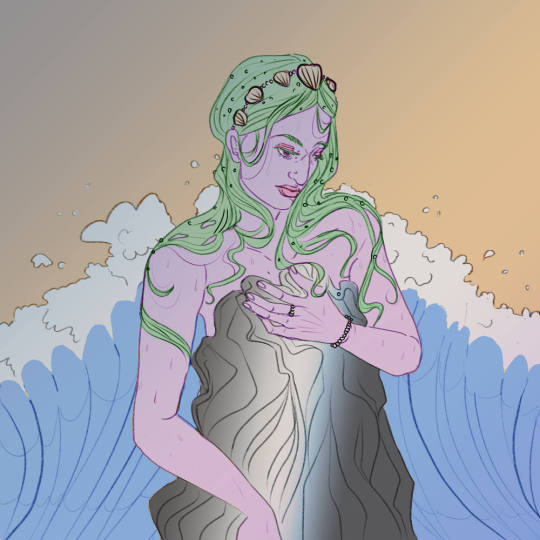
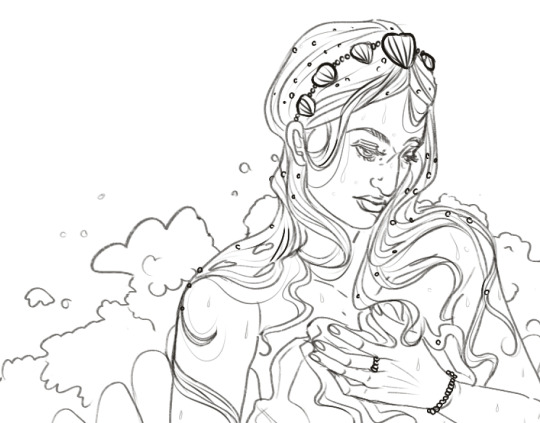
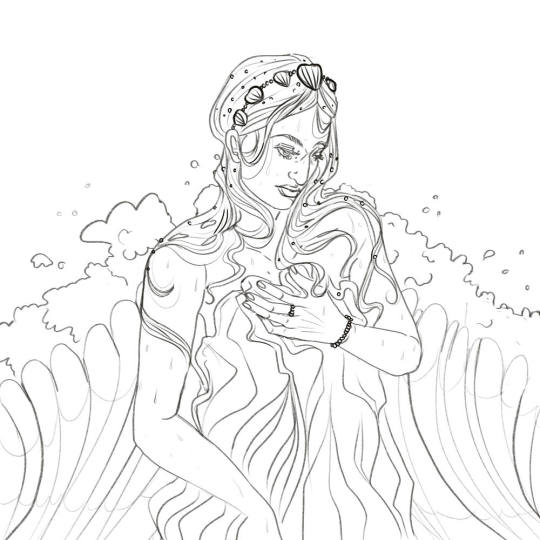
ClassicsTober23 26: 🐟Thetis
Most extant material about Thetis concerns her role as mother of Achilles, but there is some evidence that as the sea-goddess she played a more central role in the religious beliefs and practices of Archaic Greece. The pre-modern etymology of her name, from tithemi (τίθημι), "to set up, establish," suggests a perception among Classical Greeks of an early political role.
#illustration#artists on tumblr#chiara cognigni's art#chiara's art#digital illustration#digital art#fanart#art#classicstober 23#classic literature#the illiad#thetis#the song of achilles#achilles#greek myth art#greek mythology#greek gods#nymph aesthetic#sea#shell#pearl#lofi aesthetic
61 notes
·
View notes
Text

so i was reading the song of achilles and i
12 notes
·
View notes
Text

WIP Wednesday Thursday
my notifications must be well and truly busted, because tumblr didn’t bother to tell me that @aroace-genderfluid-sheep @erzbethluna and @confused-bi-queer all tagged me for WIP Wednesday yesterday until now, which is evidently no longer Wednesday. thanks anyway, guys!
but i’ve been staying up until 5 the past few nights engaged in a new WIP, so the petty constraints of linear time won’t stop me!
it’s not Carry On related, but i was tagged on this account so i’ll post it here anyway.
it’s sort of a retelling of the trojan war, except it’s set 18 years later and is all about the aftermath and the survivors. i try to stay mostly true to the sources, but also patch up any holes. like Briseis. she’s a major part of the Iliad, but then we just never find out what happens to her after Achilles dies! what??
it’s told from the perspective of Astyanax, who you may know was the infant son of Hector, the crown prince of Troy, and was thrown from the walls of the city when the war ended. except a lot of sources outside of Homer posit that he didn’t 👀
my Astyanax, who is non binary, was raised by his aunts Oenone, the first wife of Paris, and Cassandra, who also narrowly escaped death. but when Cassandra prophecies that they must make amends with the house of Achilles and Hector’s ghost urges them to find their mother Andromache, they set out an adventure and piece together the aftermath of the war as they go.
so yeah. i’ve spent the past few nights writing a rather long and detailed outline, making character picrews, and creating a big messy family tree. so here’s an excerpt, and i’ll put the family tree below too just for fun.
cw for mentions of rape
“Did Oenone ever tell you I was married?” Cassandra pulls up a handful of grass and twists her fingers in it, looking out to the sea.
“No.” Oenone told me so much about my family. I can recite all 99 of my aunts and uncles, as well as their spouses. But not Cassandra’s. I never knew. I wonder what else she never told me, and why.
“His name was Coroebus. I put off marriage for years. Becoming a priestess helped, and my supposed madness drove plenty of potential suitors away, but there are always men willing to look past an unpleasant wife if the alliance brings them power.” She throws the grass down and mumbles “no, that’s not fair to him. He was a good man.” She takes a deep breath. I wait in silence, not wanting to spook her.
“My parents forced me to marry him eventually. He was a king who came to Troy’s aid, I was their thanks, and they thought he might calm me down. He was gentle, and considerate, so I tried to be good. He listened to me, even if he didn’t believe me. And I never had any visions of what was to become of him, which was a mercy. Not that it mattered. That damned horse showed up just three days after we married. He died protecting me in the temple, and then that brute Ajax…” Her breath catches, she squeezes her eyes shut and shakes her head. “His body was only a few feet away.”
I don’t even know what to say. Everyone suffered that night, death and loss and rape all across the city. I know it, but I can’t wrap my head around the enormity of it. I understand suddenly why it’s so hard for her to look upon the city’s ruins.
At a loss for words, I lean over and wrap my arms around her, letting her rest her head on my shoulder. She laughs brokenly. “I think this is supposed to be the other way around. You’re the baby of the family.” I don’t fight her about it this time. After a few minutes, she pulls away and wipes at her eyes.
“How do you live with it?”
“How do any of us?” She asks incredulously. “Oenone lives in the past, and when she runs out of ways to run from reality she turns into a rock.” She clasps my hands and meets my eyes, darkest brown with a pinprick of red fire dancing deep within. “I’ll tell you my secret. Every morning, when I wake up, I lie there and I list them. Everyone who died, for Troy, for me. My parents, my siblings, Coroebus, the Amazons. And then I get up, and I live that day for them.” I squeeze her hands, and she squeezes them back. “Do you understand? We live for them.”
and here’s the mess of a family tree, with Priam and Hecuba’s other 96 kids not pictured.
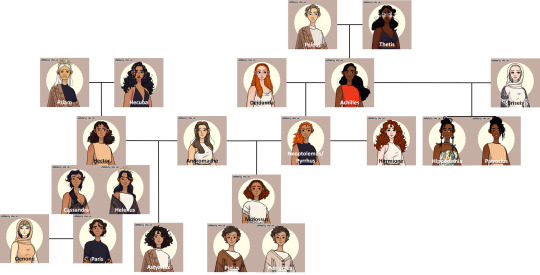
#wip wednesday#and yes before anyone kills me for it my achilles is black#listen. thetis would have been black. she’s a sea nymph. the sea refracts light. that’s why you’re more likely to get sunburned swimming.#it just makes sense.#achilles’s skin tone is never mentioned. just his hair colour. but nobody can agree if it’s blonde or red or something else.#just that it’s shiny and it reflects his divinity. black hair is shiny. and if his divine mother is black…#i accept no criticism#also i was trying to reconcile madeline miller briseis being black and mythological briseis being super pale and blonde so she’s albino.#bam. sorted.
8 notes
·
View notes
Text
just need to be next to a body of water rn

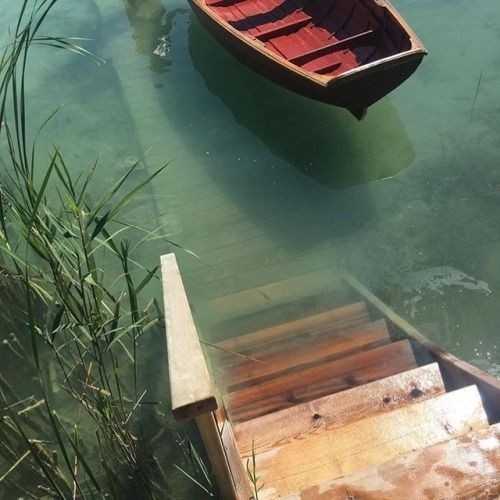


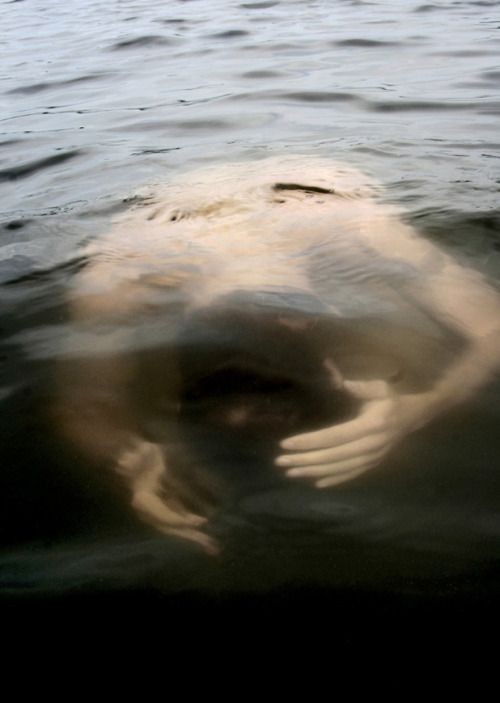
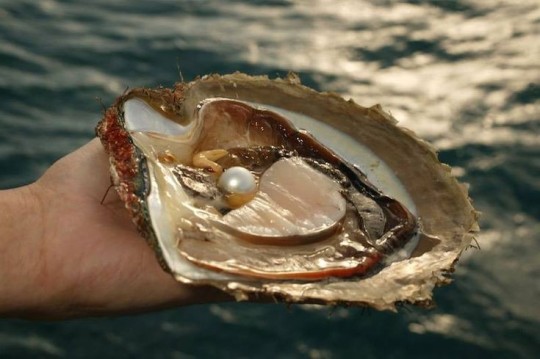

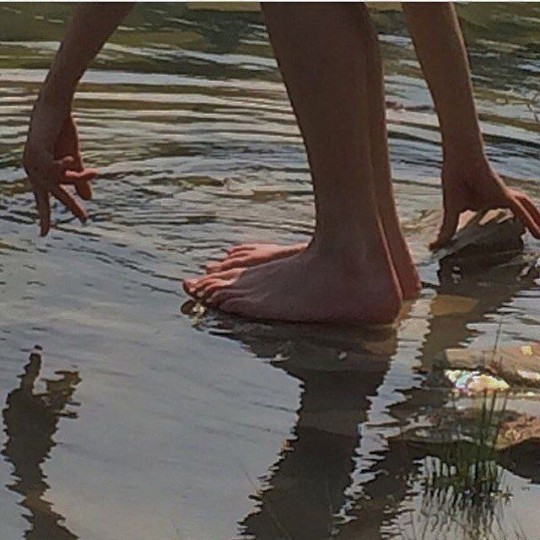

11 notes
·
View notes
Text


Hera and the Nereid (sea nymph) Thetis, her foster daughter.
#ancient greek mythology#thetis#hera#nereid#character design#medusa's peach#couldnt decide which version
2K notes
·
View notes
Text

All right folks, Argonautica is a go! woohoo!
I wanted to start with a map just so i could wrap my head around the journey and get familiar with the major locations and events in chronological order. I'll do another image showing the major heroes, and then we can dive into individual scene/event illustrations. Ill probably do around 12 -14 images for this myth, so I'll have to be picky about which scenes i illustrate.
Argonautica 1: Overview and Map Route
I.) Iolcis; The crew departs from Jason’s hometown.
II.) Lemnos; the island tribe of women who murdered their husbands.
III.) Doliones battle: a mistaken battle results in the death of King Cyzicus
IV.) Chios: Hylas abducted by water nymph, Heracles left behind
V.) Phineus, a blind seer, is rescued by the Argonauts from Harpies.
VI.) The Symplegades (Clashing rocks) a treacherous passage.
VII.) Stymphalian birds: the heroes drive away the man -eating birds
VIII.) Colchis; Jason overcomes three trials of King Aeetes to obtain Golden Fleece with the assistance of the sorceress Medea.
IX.) Brygean Islands: Medea and Jason trick and murder her brother Apsyrtus to escape Colchian pursuit.
X.) Circes Island; The goddess purifies Jason and Medea of blood-guilt.
XI.) The Sirens; Orpheus drowns out the sirens calls with his own song.
XII.) Scylla and Charybdis; Thetis and Nereids guide Argo through
XIII.) Drepane Island: escaping 2nd Colchian fleet, Jason and Medea wed.
XIV.) Syrtes: three Nymphs instruct crew to carry Argo on their backs for 12 days
XV.) Garden of the Hesperides;
XVI.) Lake Triton: Triton, Son of Poseidon, instructs crew on passage to sea
XVII.) Crete: Medea uses her magic to defeat Talos, a giant bronze warrior
XVIII.) Aegina Island: the journey ove r, they perform rites for Apollo
Do you like this art? would you like to own a book jam packed with over 130 illustrations like this? Then please support my kickstarter for my book "lockett Illustrated: Greek Gods and Heroes" coming in OCTOBER.
click on my LINKTREE for the Kickstarter link to "notify me when the project goes live." In my linktree is also a link to join my free email newsletter for book updates in the coming months, with free Hi res art and a 25% etsy print shop discount!
#pagan#hellenism#greek mythology#tagamemnon#mythology tag#percyjackson#dark academia#greek#greekmyths#classical literature#percy jackon and the olympians#pjo#homer#iliad#classics#mythologyart#art#artists on tumblr#odyssey#literature#ancientworld#ancienthistory#ancient civilizations#ancientgreece#olympians#greekgods#zeus#hesiod
429 notes
·
View notes
Note
This has been buggibg me for a while. What is the reason why Rachel dehumanizing nymphs?
Cause from what I'm seeing the nymphs getting the most screen time is Daphne, Minthe, Thetis, Psyche and a little bit of Leuce and Echo.
4 out of the 6 nymphs we see are very open in their sex appeal and flirty. Yet for some reason they get discriminated when Hera, Persophone, and Aphrodite do the same thing but get a pass because the are white coded rich people.
For my knowledge (but I could be wrong if so please correct me) nymphs are known to be seductive and sexy but they were well respected just like any other God. They were given given sacrifices to please them.
Is this just another case of Rachel being the so-called "folkorists" who has done the first Google link she see or could there just be how she interprets then but like the rest of her story misses the mark?
So there are a couple different and equally interesting theories on this.
Rachel has established it as canon that the nymphs are lower class. And there are a lot of stereotypes and prejudices against lower class women going into sex work, which we see in LO through characters like Minthe who work as car girls (notice how in the present story Thetis and Minthe are both personal assistants which is also a role that's commonly stereotyped as "the boss' sidepiece" as it's a role often occupied by women in service to men). Even Leuce isn't safe from this:
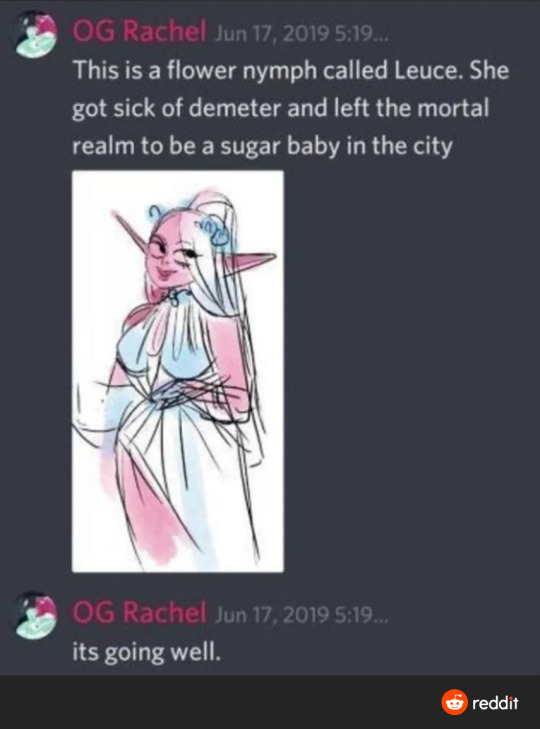
Normally I'd just say "good for her" but it's clear with how much Leuce has been turned into the delusional girl who "manifests" her fantasies that Rachel is once again conflating sexuality with more negatively-associated character traits for any woman who isn't Persephone (because when it's Persephone it's sexual liberation always, she's not a "sugar baby", she's a "workaholic" who "earned her position and wealth", but when it's Leuce or Minthe or Thetis they're "homewreckers") And yeah, this is a common disconnect that happens between lower class and upper class people, where lower class people (especially women) are often judged and outcast for doing certain things or behaving a certain way which rich upper class people take and adopt and turn into something "trendy" and "empowering".
But there's... another theory that may explain why so many nymphs in the story are being pigeonholed into the "homewrecking sugar babies" stereotype. And you're gonna hate me for this, because I'm sure the gut reaction to reading this from many is gonna be "goddamit not Lolita again!" buuuttt yeah we're gonna talk about Lolita again.
CONTENT WARNING: We're talking about Lolita again, which means discussion surrounding the sexualization of minors is ahead.
There's a certain term the main character of the book Humbert Humbert uses to describe girls who are specifically, and I quote:
"Between the age limits of nine and fourteen there occur maidens who, to certain bewitched travellers, twice or many times older than they, reveal their true nature which is not human, but nymphic (that is, demoniac); and these chosen creatures I propose to designate as 'nymphets'." - Lolita, Chapter 5, Page 18, paragraph 5
It's also very clear from the way Nabokov specifies the definition of nymphet from Humbert Humbert's perspective that the use of the word 'nymphet' is intentionally referencing the root word of Greek origin:
"...I would have the reader see 'nine' and 'fourteen' as the boundaries - the mirrory beaches and rosy rocks - of an enchanted island haunted by those nymphets of mine and surrounded by a vast, misty sea. Between those age limits, are all girl-children nymphets? Of course not. Otherwise we who are in the know, we lone voyagers, we nympholepts, would have long gone insane."
Though Humbert Humbert is obviously not being literal here, the visual metaphor is strongly relying on the etymology of the word 'nymph', but twisting the depiction of nymphs in such a way to support his own fantasies.
And while I'm definitely not trying to accuse Rachel of having the same mindset of Humbert Humbert (seriously, I want to make it clear that I don't think Rachel is a pedophile, just horribly misled at best), it's interesting to me how this specific definition of a nymphet matches with that of Rachel's old descriptions of her own art:

"You have to be an artist and a madman, a creature of infinite melancholy, with a bubble of hot poison in your loins and a super-voluptuous flame permanently aglow in your subtle spine (oh, how you have to cringe and hide!), in order to discern at once, by ineffable signs - the slightly feline outline of a cheekbone, the slenderness of a downy limb, and other indices which despair and shame and tears of tenderness forbid me to tabulate - the little deadly demon among the wholesome children; she stands unrecognized by them and unconscious herself of her fantastic power."
What's interesting is that I did dig up an old profile of Rachel's that actually acknowledged that what she's doing with her art shouldn't be conflated with, well... child porn.
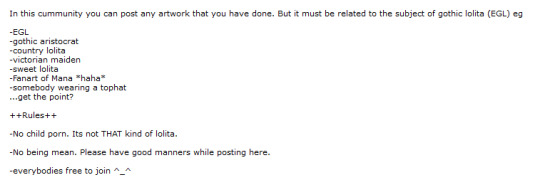
"It's not THAT kind of lolita" and yet the writing feels like it's been smeared all over the wall with shit. There are so many scenes and artistic choices throughout LO that scream "it is that kind of lolita".
Though it is still a theory, and I don't resort to using Rachel's old art of "proof" of LO's shortcomings, I don't think it should necessarily be ignored that the nymphs in LO seem to be characterized very similarly to Humbert Humbert's description of 'nymphets' - devious and promiscuous, and thus easier to blame when predatory men pursue them, rather than holding those predatory men accountable. And we see this in Persephone too, but unlike the nymphs, Persephone is rich, upper class, and of a "superior pedigree". So she becomes the desirable form of a 'nymphet' that's praised and celebrated by the narrative and characters like Hades, rather than the literal nymphs who are shamed and outcast for simply having sexual independence.
Whatever theory you roll with is on you, you can dismiss all this as just overthinking nonsense, but I do think it makes for interesting food for thought because at this point, LO is undeniably - intentionally or subconsciously - influenced by Rachel's relationship with Lolita, and whether or not that influence is aware at all of Lolita being originally written to be a precautionary tale, that remains to be seen.
#lore olympus critical#anti lore olympus#lo critical#ask me anything#ama#anon ama#anon ask me anything
132 notes
·
View notes
Text








THETIS | ˈθɛtɪs ≡ one of the fifty sea nymphs known as the nereids, daughter of the ancient sea god nereus. she married peleus, a mortal hero who had distinguished himself as one of the argonauts, and had a son: the warrior achilles.
#mythedit#mythologyedit#greek mythology#mythology#paletmblr#palesources#palemakers#greekmythologyedit#aesedit#*gifs#thetis
300 notes
·
View notes
Text
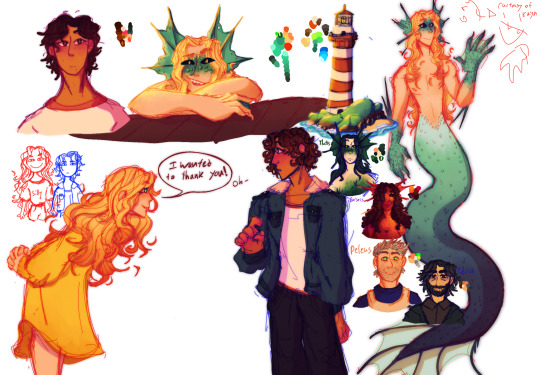
What I’m calling By the Sea au, I was thinking about how thetis is nymph and then I was like ‘what if mermaid?’ And here we are.


The second one is my favorite so far <3
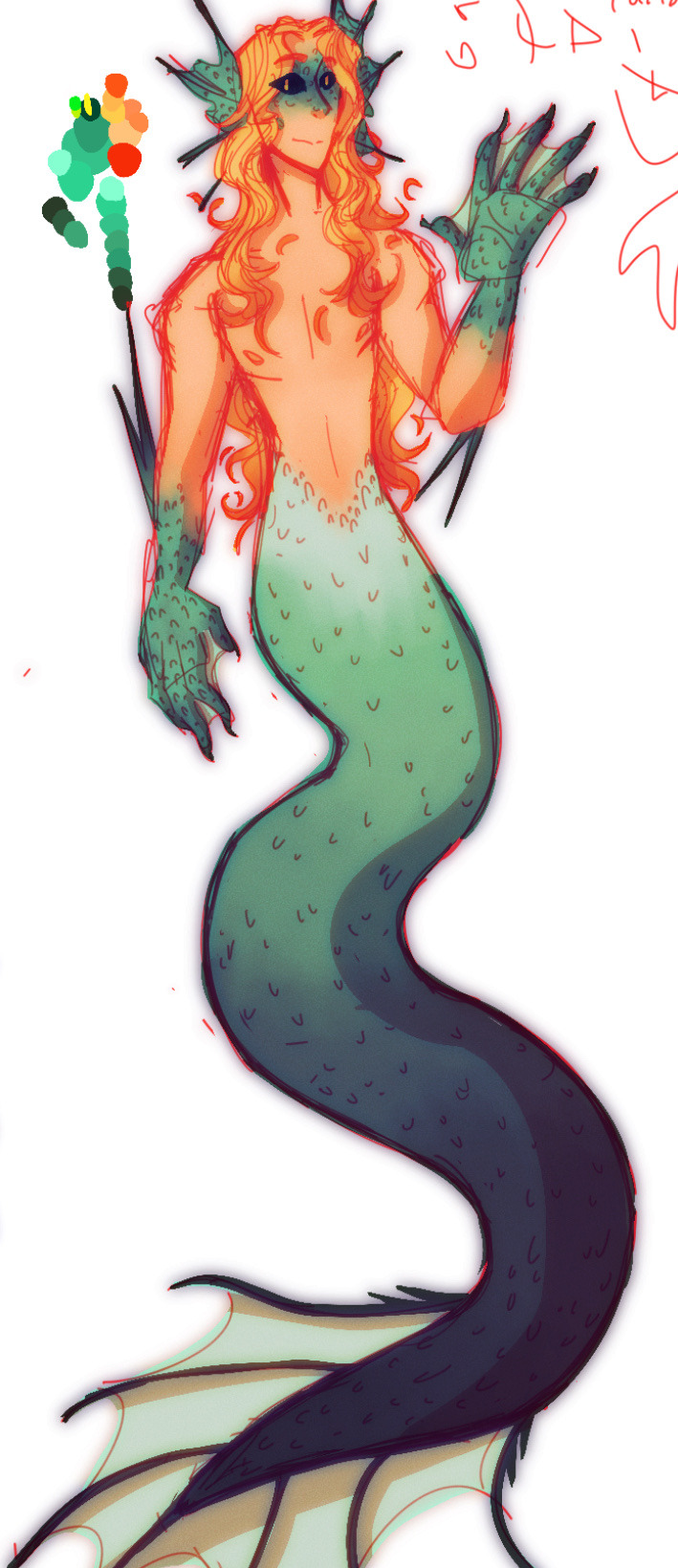
Full body mermaid form

Patroclus bust shot (ignore how long his neck is)
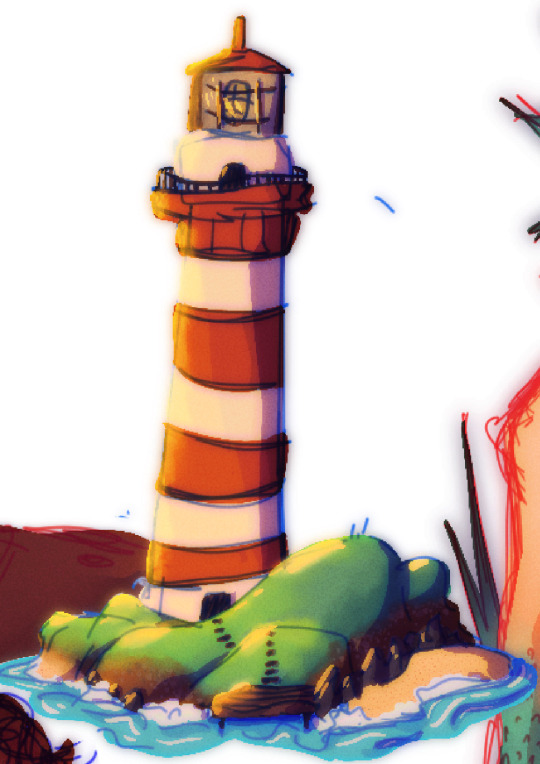
In the au Pat is a lighthouse keeper with his dad and how he first meets Achilles is when Achilles saves him from drowning when he tries to get back to the lighthouse during a storm.
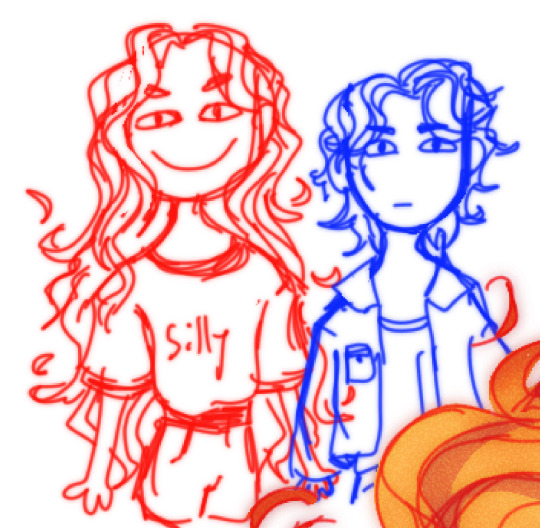
lol doodle

Peleus and thetis are in love but also kind of divorced and peleus runs a sandwich shop because why not.
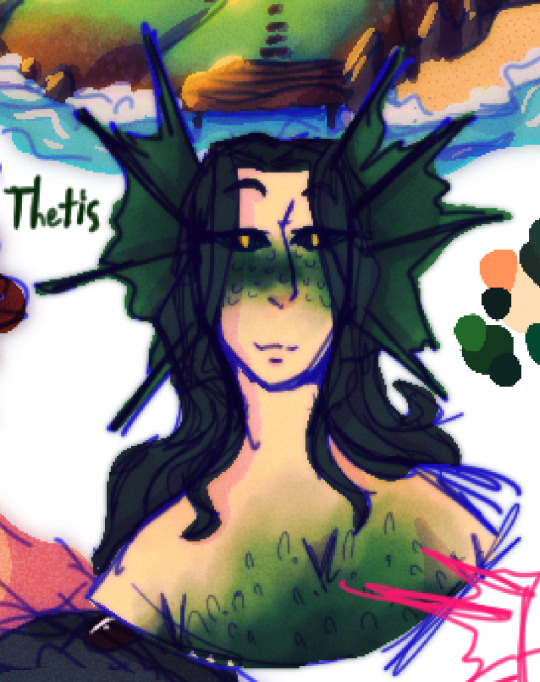
She’s a lot more chill and mostly just wants Achilles to be less reckless and not get hurt

Briseis is Achilles’s friend and she is the one who helps him do a little spell to turn human for two weeks.
#the song of achilles#song of achilles#song of achilles au#achilles#patrochilles#patroclus#tsoa thetis#tsoa achilles#tsoa patroclus#tsoa au#alternate universe#by the sea au#mstduckdraws#I’m probably going to write a fic about this someday
73 notes
·
View notes
Text

Jupiter & Thetis
Talon Abraxas
Thetis was a sea nymph in Greek mythology, or according to some myths, one of the Nereids, the fifty daughters of the sea god Nereus and Doris.
She was courted by both Zeus and Poseidon, but neither of them married her, out of fear of a prophecy that said Thetis' son would surpass his father in glory. Instead, she married Peleus, with whom she had a son, the mythical hero Achilles. Peleus' and Thetis' wedding was the main event that caused all subsequent events triggering the Trojan War.
66 notes
·
View notes
Photo



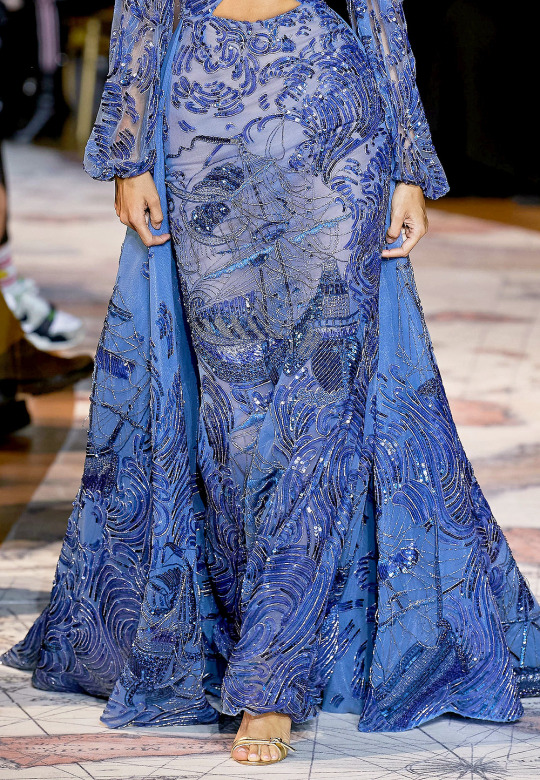
The Nereids (Νηρεις meaning ‘Daughters of Nereus’) were the fifty sea-nymph daughters of the ‘Old Man of the Sea’ Nereus in Greek mythology. They were goddesses of the sea's rich bounty and protectors of sailors and fishermen, coming to the aid of those in distress. Individually they represented various facets of the sea from the salty brine, to the sea foam, sand, rocks, waves and currents, as well as the various skills possessed by seamen. The Nereides symbolised everything that was beautiful and kind about the sea and their voices sang as they danced around their father in their home at the bottom of the Aegean Sea. The most notable of the Nereids were Thetis (goddess of the sea) and Amphitrite (queen of the sea) who was also married to Poseidon (god of the sea).
(Zuhair Murad Spring 2022 Haute Couture Collection)
#Fashion#FashionEdit#MythEdit#MythologyEdit#Couture Edit#Zuhair Murad#Haute Couture#Fashion Details#Greek Mythology#My Edit
3K notes
·
View notes
Text
Tournament 2 : Characters with Demigods' names
Round 1 Poll 7

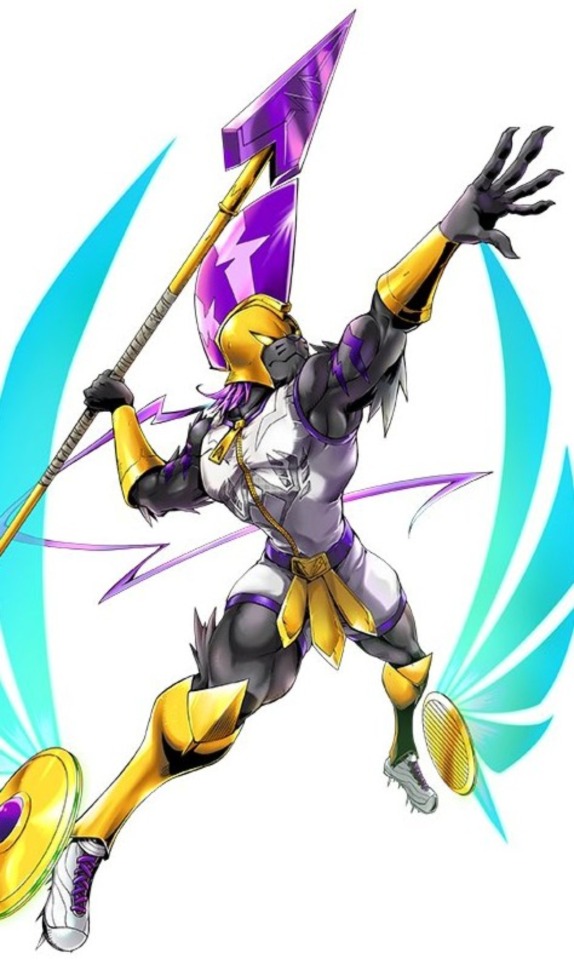
Demigods they share a name with :
- Pollux, son of the mortal Leda and the Greek god Jupiter (side note : his twin Castor is only his half-brother and his father is a mortal, hence why Castor is a mortal himself and not a demi-god)
- Achilles, son of the mortal king Peleus and the Greek sea nymph Thetis
#demigodsnames tournament#tournament polls#round 1#sollux captor#homestuck sollux#hs sollux#sollux homestuck#sollux hs#hs tag#hs fandom#homestuck fandom#homestuck tag#homestuck comic#homestuck#comicblr#webcomics#digimon games#digimon adventure#digimon#gameblr
41 notes
·
View notes
Text
For a sea nymph, Thetis really didn’t seem to understand how thirsty Achilles was for Patroclus
107 notes
·
View notes
Text
The myth of Dionysos (4)
The Dictionary of literary myths does not have just one article about Dionysos… But two! And since I translated the first, let’s journey through the second: it is titled “Dionysos: The evolution of the literary myth”, and it was written by Ann-Déborah Lévy-Bertherat.
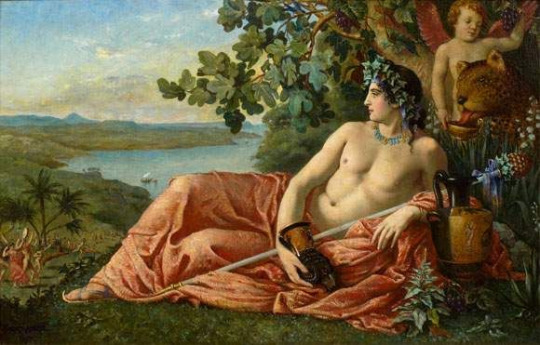
According to the imagery of the Ancient Greeks, Dionysos is supposed to be a young god – he is often depicted as a teenager, sometimes even as a child. This perhaps explains why his Greek name was thought to be the counterpart of the Phrygian “Dioskouros”, “the boy of Zeus”. However, it seems more plausible to link Dionysos’ name to Nysa, both nurse and homeland of the god. But no matter which of these explanations is right: both highlight and insist on a foreign origin for the god. A foreign origin that we know to be purely mythical rather than historical – indeed, the Mycenaean texts proved that the cult of Dionysos was implanted in Greece since a very, very old time, and was not a “recent importation” as classical Greeks believed.
But then, why make Dionysos a “foreign god”? Maybe because, in a symbolic way, it is important for Dionysos to be a god that “comes and goes”, a “god that arrived” – or maybe, it was a much needed element to explain his strange, bizarre and frightening character.
I/ Births and rebirths of Dionysos
Semele, a mortal woman loved by Zeus, died because of Hera’s jealousy: she asked her divine lover to appear before her in all of his glory, but this resulted in her death struck by his lightning. Removing the child she was bearing in her womb, Zeus placed the unborn into his own thigh, where the baby completed his growth. As such, Dionysos knew a double-birth, and his cult was deeply marked by this. One of the Dionysiac rites is the ritual of the liknites (child in crib) – where a child has to disappear and be searched by women in vain, for he will only reappear one year later.

The Passion of Dionysos: The myths of Dionysos’ childhoods and wanderings depict him as a persecuted god. One time he is dismembered, boiled and devoured by the Titans before being resurrected by Demeter. Another time Hera curses with madness Semele’s sister, Ino, first nurse of the god. In a third tale pirates kidnap the child to sell him as a slave. Homer, in the Iliad, retells of how Lycurgus, armed with an axe and a desire to kill, hunted down Dionysos and his nymph-nurses – the child had to throw himself into the sea, where he was saved by Thetis. The true “passion” of Dionysos (in the Christian meaning of the term) always suffering, always dying, but always resurrecting, seems to be a symbol of the vegetal cycle. As a result, it is no coincidence that the four great holidays of Dionysos are all placed between the end of December and the beginning of April – aka, between the winter solstice and the arrival of spring.
Ivy and vine: Legends insist on the ties between Dionysos and other vegetal deities, such as Cybele or Rhea – two incarnations of the great Earth-mother, two deities that shield Dionysos from Hera’s revenge. There are the agrarian nymphs that constantly surround the god; there is his lover, Ariadne, that was originally a Minoan goddess of vegetation; and there is of course Demeter, to which he is tied through the Mysteries of Eleusis (and Pindar even goes as far as making Dionysos and Demeter a couple). Dionysos is also called Bacchus (a named which, according to Euripides, comes from “bacchos”, the “branch” the “bough”) ; he is said to be a “ploutodotes”, a “wealth-giver” ; he was believed to give strength to plants and to help them grow ; and among his numerous attributes, his most prominent ones are the ivy (of which he is crowned) and the grapevine (which he offered to the world). These two plants have always a savior role in his myths. It was said that the child Semele bore was protected from the lightning by ivy ; the pirates were frightened when ivy and vine started growing around their ship’s mast ; a nymph hunted by Lycurgus turned herself into vine to choke the murderous king… And yet, these two plants are such a contrast they can only make the god ambiguous: ivy is coldness and sterility, where the grapevine is warmth and generosity. Dionysos is almost most famed as the god of wine: it is the wine that symbolizes the presence of the gods during festivals; during the Lenaia festival (January-February) the new wine is offered to the god (symbolized as a bough-decorated mask). Dionysos “polygethes” (joyful, happy) is said, according to Euripides, to have the power to “laugh and put to sleep all our problems”.
Fertility and fecundity: This god, friend of the nymphs, who found a home with Thetis at the bottom of the sea, whose statue is ritually plunged in water at Halai, who was said to have entered Athens on a naval chariot, has too many affinities with water and humidity (an universal symbol of fertility) for his power to limit itself just to plants. Indeed, let us take a look at his cohorts and parades: w find in there donkeys, goats and bulls, usually painted in an ithyphallic position; and he is surrounded by Satyrs and Silenes whose lubricity and lust are meant to parallel the chastity of the Maenads. Dionysos himself, during the Anthesteria festival (February-march) knows a physical and sexual union with the Basilinna, and by doing so ensures one year of fecundity for all of Athens. The exaltation of fertility in Dionysos’ cult is most expressed through phallophoria – but the particularity of Dionysos is that he depicts a complete and “full” fecundity, with both its masculine and feminine attributes. Dionysos, in his myth like in his cult, is surrounded by women: Aeschylus calls him “effeminate”, explaining his youthfulness (he hasn’t grown a beard or body hair yet), and his clothes (he usually wore the women’s peplum). Some even depict him as an androgynous figure, and the ambiguity of his sex reminds the one of the hermaphrodite and their “ideal fecundity”. The French poet Baudelaire will even interpret the thyrsus, a long, leafed staff held by the followers of the god, as the union of the masculine symbol (the straight staff) and the feminine one (the curvy boughs wrapped around it). Dionysos is “polygethes” and “ploutodotes” – but reducing Dionysos to this sole role would be removing from him his “dark side”, the eviler part of his power. For Homer calls him “mainomenos”, the “demented one”. He is a god that disturbs, he is a god that break the order.
More about this next time, in “The Frenzied God”!
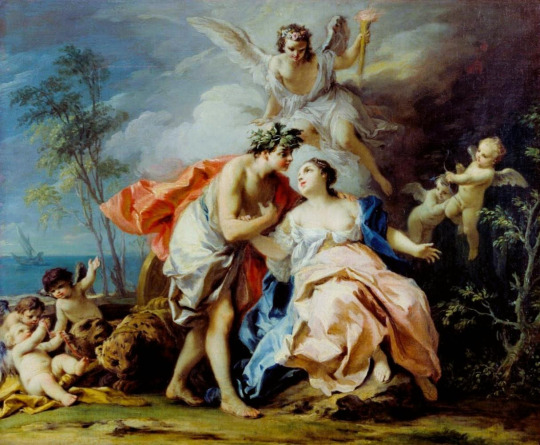
49 notes
·
View notes
Text
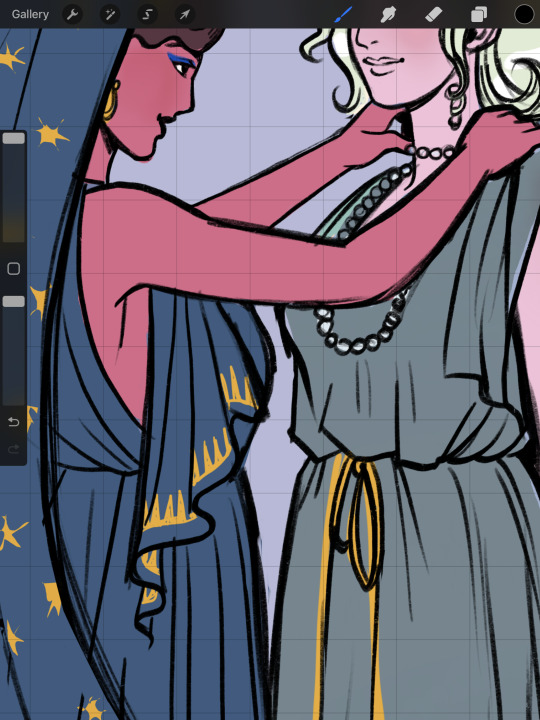
preview of Hera and the Nereid (sea nymph) Thetis, her foster daughter.
176 notes
·
View notes